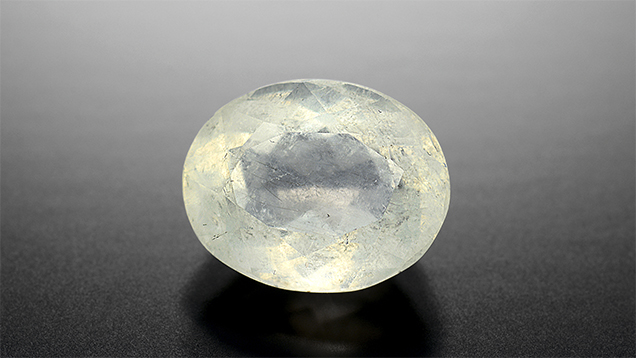Faceted Milarite

Recently the Carlsbad lab received a light yellow 2.07 ct unknown gemstone (figure 1). The measured refractive index was 1.548–1.550 with a birefringence of 0.002. The specific gravity, measured hydrostatically, was 2.52. These properties were consistent with the mineral milarite, which was confirmed by Raman spectroscopy (figure 2). The stone showed planar/patterned liquid inclusions resembling a honeycomb pattern and also contained needle-like inclusions.

Milarite is fairly rare but gives its name to a somewhat large group of silicates, namely the milarite-osumilite group. This group is composed of similar cyclosilicate minerals that are very rare and obscure. Crystals are generally small and often have a muted green or yellow color, and they occur as well-formed prismatic hexagonal crystals. Milarite is a hexagonal-dihexagonal dipyramidal mineral with a composition of K2Ca4Al2Be4Si24O60•H2O. It forms as a primary mineral in granitic pegmatite, low-temperature hydrothermal veins, and alpine clefts.
The mineral was named by Gustav Kenngott (1870) after he mistakenly identified its provenance as Val Milar, located in eastern Switzerland. The original specimens actually came from neighboring Val Giuf. Even though milarite was the first newly described mineral from a Swiss Alpine fissure, it took more than 60 years to identify the mineral’s true chemical nature, in particular its Be content. Milarite was originally known as a green mineral, until fine yellow crystals were discovered in Mexico in 1968. Larger Mexican crystals with transparent areas have occasionally been faceted into small gems with a pleasing appearance, but these are exceedingly rare.
Outside of Switzerland, notable occurrences have been recorded in Brazil, Mexico, Germany, Russia, Canada, Italy, Norway, and the Czech Republic. Nevertheless, this is the first example of faceted milarite ever examined by the Carlsbad laboratory.



